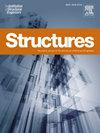Image-assisted seismic damage evaluation for reinforced concrete interior beam-column joints
IF 3.9
2区 工程技术
Q1 ENGINEERING, CIVIL
引用次数: 0
Abstract
Seismic damage quantification for reinforced concrete (RC) interior beam-column joints is crucial for post-earthquake stability and safety assessment of existing RC buildings. Loading-induced cracks during earthquake excitation usually degrade structural strength, ductility, and stiffness, underscoring the importance of rational assessment for RC joints. In this study, an image-assisted seismic damage evaluation method for RC interior beam-column joints was suggested by incorporating image-assisted technology, feature selection techniques, and regression models. Three seismic damage evaluation indicators derived from drift ratio (DID), stiffness (DIS), and strength (DIF) were first introduced as the poor prognosis markers of RC damaged joints. Secondly, image-assisted feature extraction method was presented by pre-processing image to a consistent binary format, with textural and geometric attributes of surface crack patterns extracted as part of features for three evaluation tools. Next, hybrid-feature parameters by combing image features and structural parameters were jointly selected by combing MRMR algorithms and F-test. Lastly, seismic damage evaluations of RC joints were performed based on four machine learning models (e.g., Neural Network, Gaussian Process, Random Forest, and Gradient Boosting) and 194 images from 37 available studies. Results indicate the highest accuracy for seismic damage derived from drift ratio can reach a robust R2 of 0.83. SHapley Additive exPlanations (SHAP) analysis of the proposed model further deepens the understanding of seismic damage recognition and provides insights into the intricate relationships between predictors and damage evaluation tools.
求助全文
约1分钟内获得全文
求助全文
来源期刊

Structures
Engineering-Architecture
CiteScore
5.70
自引率
17.10%
发文量
1187
期刊介绍:
Structures aims to publish internationally-leading research across the full breadth of structural engineering. Papers for Structures are particularly welcome in which high-quality research will benefit from wide readership of academics and practitioners such that not only high citation rates but also tangible industrial-related pathways to impact are achieved.
 求助内容:
求助内容: 应助结果提醒方式:
应助结果提醒方式:


